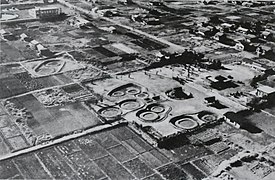Toro (Japan)
Toro ( Japanese 登呂 遺跡 , Toro iseki, "Toro site") is an archaeological excavation site from the late Yayoi period , 130 km south of Tokyo, in the Toro district of the Suruga district of Shizuoka in Shizuoka Prefecture , Japan .
overview
Toro is believed to be the first archaeological dig site to find remains of wet rice cultivation from the 1st century AD, the late Yayoi period. The site was discovered in 1943 during construction work for an armaments factory during the Second World War and opened up in the following years 1947–48. In addition to the remains of the landscape, architectural remnants of "earth pit" and "ground dwellings" were also found. Toro is particularly important because it was an almost complete settlement from the Neolithic Age and because the state of preservation of the finds was so good that 2000 year old wooden tools were found. Further artefacts were discovered during renewed excavations from 1999 to 2004.
The archaeological finds at Toro aroused such interest among Japanese archaeologists that the Japanese Archeology Association was formed in 1948 to investigate the finds. Although it was assumed that northern Kyūshū was the center of the incipient settlement in the Yayoi period and the Tōkai region in which Toro is located played a marginal role, the excavation site is now regarded as an eponymous site .
Excavation site
The total size of the Toro archaeological site is 330,000 m². A total of 12 dugouts were discovered and two pile dwellings, which are believed to have been used for storage. The dugout apartments offer a living space of approx. 6 x 8 meters surrounded by a double 30 cm high stone border. Four wooden pillars support a hipped roof , the rafters of which reach almost to the ground and which was covered with straw. The high dwellings had a wooden ladder at the entrance that was tapped .
In addition, 30 rice fields with 370 meters long and narrow irrigation channels were excavated.
The site is currently a public park, which since 1952 after the Cultural Property Protection Act as a nationwide " special historic site " (Special National Historic Site) is classified. The complex includes five-meter-high replicas of the excavated dwellings and a museum in which many of the artifacts found can be viewed.
The area under cultural protection today is 70,182 m² smaller than the entire excavation site. This also includes an area of 59,900 m², which has been named a “Special Historic Site” and includes 24,690 m² of rice fields, 39,700 m² of settlement remains and park areas as well as 5211 m² of museum space.
photos
Individual evidence
- ↑ 登呂 遺跡 . In: デ ジ タ ル 版 日本人 名 大 辞典 + Plus at kotobank.jp. Retrieved May 17, 2012 (Japanese).
- ↑ Chū Yoshizawa, Torao Miyagawa, Nobuo Itō, Taiji Maeda: Archaic Time . In: Jürgen Berndt (Ed.): Japanese Art . tape I . Koehler & Amelang, Leipzig, p. 17 .
- ↑ 協会 に つ い て . 日本 考古学 協会 (Japanese Archeology Association), April 27, 2006, accessed May 17, 2012 .
- ↑ 登呂 遺跡 の す が た . 静岡 市立 登呂 博物館 (Shizuoka City Toro Museum), 2010, accessed May 17, 2012 (Japanese, site map of the excavation site).
- ↑ Toro Ruins. Japan Atlas, April 27, 2006, accessed May 17, 2012 .
- ↑ 収 蔵 資料 情報 . 静岡 市立 登呂 博物館 (Shizuoka City Toro Museum), 2010, accessed on May 17, 2012 (Japanese, images of some finds).
- ↑ 登呂 遺蹟 . (No longer available online.) Asahi.net, formerly in the original ; Retrieved May 17, 2012 (Japanese). ( Page no longer available , search in web archives ) Info: The link was automatically marked as defective. Please check the link according to the instructions and then remove this notice.
literature
- S. Noma (Ed.): Toro site . In: Japan. An Illustrated Encyclopedia. Kodansha, 1993, ISBN 4-06-205938-X , p. 1608.
- Brown, Delmer M. ed. The Cambridge History of Japan: Ancient Japan . Cambridge University Press, 1993 ISBN 0-521-22352-0 .
- Nishi, Kazuo. trans. H. Mack Horton. What is Japanese Architecture ?: A Survey of Traditional Japanese Architecture . Kodansha International (1996) ISBN 4-7700-1992-0 .
Web links
- Japan Atlas: Toro Ruins (English)
- official website of the Toro Museum (Japanese)
Coordinates: 34 ° 57 ′ 22 ″ N , 138 ° 24 ′ 29 ″ E





